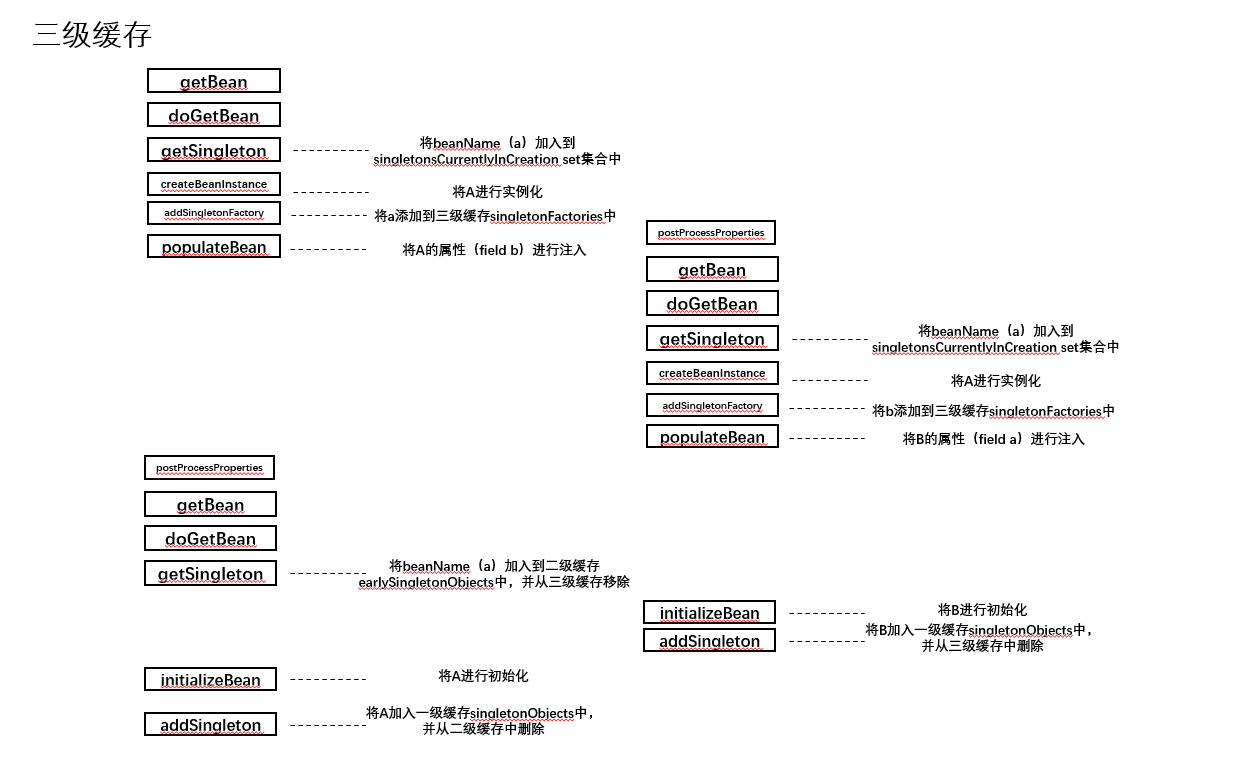Spring源码之循环依赖
https://www.cnblogs.com/longy2012/articles/12834762.html
https://www.bilibili.com/video/BV1iD4y1o7pM?p=7
https://www.jianshu.com/p/8bb67ca11831
https://cloud.tencent.com/developer/article/1497692
https://blog.nowcoder.net/n/2bb528b258b44c7eab1703a52170ef09

总结
- 在DefaultSingletonBeanRegistry类getSingleton方法中将beanName(a)加入到singletonsCurrentlyInCreation set集合中
- A进行实例化(未初始化)
- A加入三级缓存singletonFactories中
- 在AbstractAutowireCapableBeanFactory中populateBean方法中开始属性填充(field B)(调用AutowiredAnnotationBeanPostProcessor类中postProcessProperties方法)
- 在DefaultSingletonBeanRegistry类getSingleton方法中将beanName(b)加入到singletonsCurrentlyInCreation set集合中
- 将B加入singletonsCurrentlyInCreation,标志为正在创建中
- B进行实例化(未初始化)
- B加入三级缓存singletonFactories中
- 开始对B类进行属性填充(A field)
- 重新走到AbstractBeanFactory中doGetBean方法,调用DefaultSingletonBeanRegistry类getSingleton方法,将A put到二级缓存earlySingletonObjects中,并在三级缓存singletonFactories中移除
- B进行初始化
- getSingleton方法中调用DefaultSingletonBeanRegistry类afterSingletonCreation方法,将beanName(b)从singletonsCurrentlyInCreation移除
- 走到DefaultSingletonBeanRegistry中getSingleton方法finally中,将B加入一级缓存,并从三级缓存中移除
- 将B返回,A进行初始化
- getSingleton方法中调用DefaultSingletonBeanRegistry类afterSingletonCreation方法,将beanName(a)从singletonsCurrentlyInCreation移除
- 最后走到DefaultSingletonBeanRegistry中getSingleton方法finally中,将A加入一级缓存,并从二级缓存中移除
示例
- @DependsOn
@DependsOn("b")
@Component
public class A {
}
@DependsOn("a")
@Component
public class B {
}
报错:
org.springframework.beans.factory.BeanCreationException: Error creating bean with name 'b' defined
- field属性注入循环依赖(不报错)
@Component
public class A {
@Autowired
private B b;
}
@Component
public class B {
@Autowired
private A a;
}
源码解析
三级缓存
DefaultSingletonBeanRegistry类中:
/** Cache of singleton objects: bean name to bean instance. */
//一级缓存
private final Map<String, Object> singletonObjects = new ConcurrentHashMap<>(256);
/** Cache of singleton factories: bean name to ObjectFactory. */
//三级缓存
private final Map<String, ObjectFactory<?>> singletonFactories = new HashMap<>(16);
/** Cache of early singleton objects: bean name to bean instance. */
//二级缓存
private final Map<String, Object> earlySingletonObjects = new ConcurrentHashMap<>(16);
springboot中入口
调用链:
SpringApplication#run() --> SpringApplication#refreshContext() --> SpringApplication#refresh() --> ServletWebServerApplicationContext#refresh() --> AbstractApplicationContext#refresh() --> AbstractApplicationContext#finishBeanFactoryInitialization() --> DefaultListableBeanFactory#preInstantiateSingletons() --> AbstractBeanFactory#getBean() --> AbstractBeanFactory#doGetBean()
将beanName(a)加入到singletonsCurrentlyInCreation
AbstractBeanFactory#doGetBean()方法中:
if (!typeCheckOnly) {
markBeanAsCreated(beanName);
}
markBeanAsCreated方法中:
this.alreadyCreated.add(beanName);
在getSingleton方法中,执行
beforeSingletonCreation(beanName);
this.singletonsCurrentlyInCreation.add(beanName)
其中singletonsCurrentlyInCreation为
/** Names of beans that are currently in creation. */
private final Set<String> singletonsCurrentlyInCreation =
Collections.newSetFromMap(new ConcurrentHashMap<>(16));
A进行实例化(未初始化)
在在getSingleton方法执行到
singletonObject = singletonFactory.getObject();
调用匿名方法
() -> {
try {
return createBean(beanName, mbd, args);
}
catch (BeansException ex) {
// Explicitly remove instance from singleton cache: It might have been put there
// eagerly by the creation process, to allow for circular reference resolution.
// Also remove any beans that received a temporary reference to the bean.
destroySingleton(beanName);
throw ex;
}
}
调用AbstractAutowireCapableBeanFactory#createBean() --> AbstractAutowireCapableBeanFactory#doCreateBean(),执行如下代码进行实例化:
if (instanceWrapper == null) {
instanceWrapper = createBeanInstance(beanName, mbd, args);
}
Object bean = instanceWrapper.getWrappedInstance();
bean(A)具备地址
A加入三级缓存singletonFactories中
// Eagerly cache singletons to be able to resolve circular references
// even when triggered by lifecycle interfaces like BeanFactoryAware.
boolean earlySingletonExposure = (mbd.isSingleton() && this.allowCircularReferences &&
isSingletonCurrentlyInCreation(beanName));
if (earlySingletonExposure) {
if (logger.isTraceEnabled()) {
logger.trace("Eagerly caching bean '" + beanName +
"' to allow for resolving potential circular references");
}
addSingletonFactory(beanName, () -> getEarlyBeanReference(beanName, mbd, bean));
}
protected void addSingletonFactory(String beanName, ObjectFactory<?> singletonFactory) {
Assert.notNull(singletonFactory, "Singleton factory must not be null");
synchronized (this.singletonObjects) {
if (!this.singletonObjects.containsKey(beanName)) {
this.singletonFactories.put(beanName, singletonFactory);
this.earlySingletonObjects.remove(beanName);
this.registeredSingletons.add(beanName);
}
}
}
在populateBean方法中开始对A属性填充
populateBean(beanName, mbd, instanceWrapper);
对B重复上面步骤
调用链
AbstractApplicationContext#refresh() --> AbstractApplicationContext#finishBeanFactoryInitialization() --> DefaultListableBeanFactory#preInstantiateSingletons() --> AbstractBeanFactory#getBean() --> AbstractBeanFactory#doGetBean() --> AbstractAutowireCapableBeanFactory#createBean()
--> AbstractAutowireCapableBeanFactory#doCreateBean()
(上面为A,下面开始A属性B注入)
--> AbstractAutowireCapableBeanFactory#populateBean() --> AutowiredAnnotationBeanPostProcessor#postProcessProperties() --> InjectionMetadata#inject() --> AutowiredAnnotationBeanPostProcessor#inject() --> DefaultListableBeanFactory#resolveDependency() --> DefaultListableBeanFactory#doResolveDependency() --> DependencyDescriptor#resolveCandidate() --> AbstractBeanFactory#getBean() --> AbstractBeanFactory#doGetBean()
会和上面A同样做下面这些操作:
- 在DefaultSingletonBeanRegistry类getSingleton方法中将beanName(b)加入到singletonsCurrentlyInCreation set集合中
- 将B加入singletonsCurrentlyInCreation,标志为正在创建中
- B进行实例化(未初始化,具有B地址)
- B加入三级缓存singletonFactories中
- 开始对B类进行属性填充(A field)
将A put到二级缓存earlySingletonObjects中
重新对A执行doGetBean方法,执行getSingleton时,singletonFactory != null,故A放到二级缓存中,并从三级缓存中移除
Object sharedInstance = getSingleton(beanName);
protected Object getSingleton(String beanName, boolean allowEarlyReference) {
// Quick check for existing instance without full singleton lock
Object singletonObject = this.singletonObjects.get(beanName);
if (singletonObject == null && isSingletonCurrentlyInCreation(beanName)) {
singletonObject = this.earlySingletonObjects.get(beanName);
if (singletonObject == null && allowEarlyReference) {
synchronized (this.singletonObjects) {
// Consistent creation of early reference within full singleton lock
singletonObject = this.singletonObjects.get(beanName);
if (singletonObject == null) {
singletonObject = this.earlySingletonObjects.get(beanName);
if (singletonObject == null) {
ObjectFactory<?> singletonFactory = this.singletonFactories.get(beanName);
if (singletonFactory != null) {
singletonObject = singletonFactory.getObject();
this.earlySingletonObjects.put(beanName, singletonObject);
this.singletonFactories.remove(beanName);
}
}
}
}
}
}
return singletonObject;
}
B进行初始化
此时B完成属性注入,A具有地址,开始初始化:
// Initialize the bean instance.
Object exposedObject = bean;
try {
populateBean(beanName, mbd, instanceWrapper);
exposedObject = initializeBean(beanName, exposedObject, mbd);
}
将beanName(b)从singletonsCurrentlyInCreation移除
B执行完AbstractBeanFactory类匿名方法中createBean(beanName, mbd, args),接着getSingleton往下执行,在finally中:
finally {
if (recordSuppressedExceptions) {
this.suppressedExceptions = null;
}
afterSingletonCreation(beanName);
}
protected void afterSingletonCreation(String beanName) {
if (!this.inCreationCheckExclusions.contains(beanName) && !this.singletonsCurrentlyInCreation.remove(beanName)) {
throw new IllegalStateException("Singleton '" + beanName + "' isn't currently in creation");
}
}
将B加入一级缓存,并从三级缓存中移除
在getSingleton方法执行addSingleton(beanName, singletonObject);从而将B从三级缓存中移除,并添加到一级缓存中
protected void addSingleton(String beanName, Object singletonObject) {
synchronized (this.singletonObjects) {
this.singletonObjects.put(beanName, singletonObject);
this.singletonFactories.remove(beanName);
this.earlySingletonObjects.remove(beanName);
this.registeredSingletons.add(beanName);
}
}
完成A中B属性注入,对A进行初始化
A开始执行下面代码:
exposedObject = initializeBean(beanName, exposedObject, mbd);
开始将beanName(a)从singletonsCurrentlyInCreation移除;并从二级缓存中移除,添加到一级缓存
A接着getSingleton往下执行,在finally中执行afterSingletonCreation将beanName(a)从singletonsCurrentlyInCreation移除;
最后在addSingleton(beanName, singletonObject)将A从二级缓存中移除,添加到一级缓存
面试问题
- 一级缓存是否够用?
不能。多线程情况下,会获取到实例化但没有初始化的对象,属性都为null
- 二级缓存是否够用?
如果创建是普通类,二级缓存满足
- 为什么需要三级缓存?(代理)
在动态代理中,返回是代理类。如果没有三级缓存,最开始放置是实例化好对象,然后缓存有了,后面进行代理处理,那原来的对象是否覆盖??
/**
* Obtain a reference for early access to the specified bean,
* typically for the purpose of resolving a circular reference.
* @param beanName the name of the bean (for error handling purposes)
* @param mbd the merged bean definition for the bean
* @param bean the raw bean instance
* @return the object to expose as bean reference
*/
protected Object getEarlyBeanReference(String beanName, RootBeanDefinition mbd, Object bean) {
Object exposedObject = bean;
if (!mbd.isSynthetic() && hasInstantiationAwareBeanPostProcessors()) {
for (BeanPostProcessor bp : getBeanPostProcessors()) {
if (bp instanceof SmartInstantiationAwareBeanPostProcessor) {
SmartInstantiationAwareBeanPostProcessor ibp = (SmartInstantiationAwareBeanPostProcessor) bp;
exposedObject = ibp.getEarlyBeanReference(exposedObject, beanName);
}
}
}
return exposedObject;
}
Spring源码之循环依赖的更多相关文章
- Spring源码解析——循环依赖的解决方案
一.前言 承接<Spring源码解析--创建bean>.<Spring源码解析--创建bean的实例>,我们今天接着聊聊,循环依赖的解决方案,即创建bean的ObjectFac ...
- Spring IOC 容器源码分析 - 循环依赖的解决办法
1. 简介 本文,我们来看一下 Spring 是如何解决循环依赖问题的.在本篇文章中,我会首先向大家介绍一下什么是循环依赖.然后,进入源码分析阶段.为了更好的说明 Spring 解决循环依赖的办法,我 ...
- 3.2spring源码系列----循环依赖源码分析
首先,我们在3.1 spring5源码系列--循环依赖 之 手写代码模拟spring循环依赖 中手写了循环依赖的实现. 这个实现就是模拟的spring的循环依赖. 目的是为了更容易理解spring源码 ...
- 3.4 spring5源码系列--循环依赖的设计思想
前面已经写了关于三篇循环依赖的文章, 这是一个总结篇 第一篇: 3.1 spring5源码系列--循环依赖 之 手写代码模拟spring循环依赖 第二篇: 3.2spring源码系列----循环依赖源 ...
- 3.1 spring5源码系列--循环依赖 之 手写代码模拟spring循环依赖
本次博客的目标 1. 手写spring循环依赖的整个过程 2. spring怎么解决循环依赖 3. 为什么要二级缓存和三级缓存 4. spring有没有解决构造函数的循环依赖 5. spring有没有 ...
- 小白都能看懂的 Spring 源码揭秘之依赖注入(DI)源码分析
目录 前言 依赖注入的入口方法 依赖注入流程分析 AbstractBeanFactory#getBean AbstractBeanFactory#doGetBean AbstractAutowireC ...
- 【Spring源码解析】—— 依赖注入结合SpringMVC Demo-xml配置理解
在IOC容器初始化的梳理之后,对依赖注入做一个总结,就是bean实例化的过程,bean的定义有两种方式,一种是xml文件配置,一种是注解,这里是对xml配置文件的依赖注入的介绍,后续对bean与该部分 ...
- Spring源码-循环依赖源码解读
Spring源码-循环依赖源码解读 笔者最近无论是看书还是从网上找资料,都没发现对Spring源码是怎么解决循环依赖这一问题的详解,大家都是解释了Spring解决循环依赖的想法(有的解释也不准确,在& ...
- Spring源码分析(十七)循环依赖
本文结合<Spring源码深度解析>来分析Spring 5.0.6版本的源代码.若有描述错误之处,欢迎指正. 实例化bean是一个非常复杂的过程,而其中比较难以理解的就是对循环依赖的解决, ...
随机推荐
- java 图片相似度算法
利用直方图原理实现图像内容相似度比较 ,作为笔记记录在随笔中. public class PhotoDigest { public static void main(String[] ...
- snappy压缩/解压库
snappy snappy是由google开发的压缩/解压C++库,注重压缩速度,压缩后文件大小比其它算法大一些 snappy在64位x86并且是小端的cpu上性能最佳 在Intel(R) Core( ...
- rsync安装使用中出现的报错
一,查看本地centos的版本: [root@localhost lib]# cat /etc/redhat-release CentOS Linux release 8.1.1911 (Core) ...
- 【服务总线 Azure Service Bus】ServiceBus 队列中死信(DLQ - Dead Letter Queue)问题
Azure Service Bus 死信队列产生的原因 服务总线中有几个活动会导致从消息引擎本身将消息推送到 DLQ. 如 超过 MaxDeliveryCount 超过 TimeToLive 处理订阅 ...
- vue实现循环滚动列表vue-seamless-scroll
1.安装 vue-seamless-scroll 实例文档链接 cnpm install vue-seamless-scroll --save 2.文件中引入,组件配置 import vueSea ...
- centos之间如何实现免密ssh登陆
在公司产品中,管理平台和下面的主机很多时候都要求免密,免密的逻辑到底是怎么样的呢?今天就简单看看! 首先创建两台虚机,正常情况下ssh登陆对方是需要密码的 先通过ssh-keygen生成一对秘钥 [r ...
- cp: cannot stat: filepath Permission denied
在执行 cp -r frompath topath时,报错cp: cannot stat: frompath Permission denied. 百度,google都没有找到解决方案,无意中发现,原 ...
- 常见的Python运行时错误
date: 2020-04-01 14:25:00 updated: 2020-04-01 14:25:00 常见的Python运行时错误 摘自 菜鸟学Python 公众号 1. SyntaxErro ...
- vue组件使用name属性来生成递归组件
先来个简单的数据 1 lists = [{ 2 id: 1, 3 title: '第一层', 4 children: [{ 5 id: 3, 6 title: '第二层', 7 children: [ ...
- Elasticsearch启动报错:future versions of Elasticsearch will require Java 11
1 future versions of Elasticsearch will require Java 11; your Java version from [C 2 :\Program Files ...
